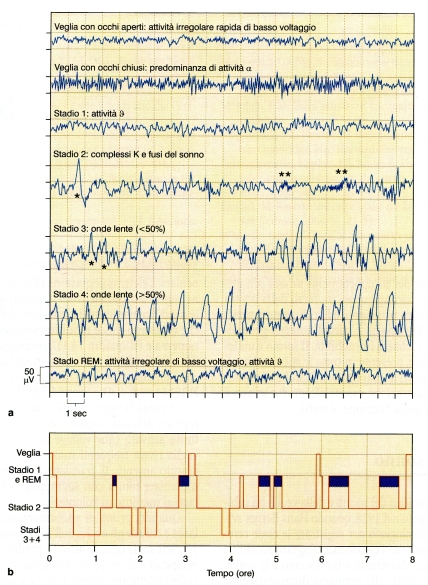The different stages of sleep
 Fig. 1: Hans Berger. The first person to record electric activity in the human brain, in 1924. |
Electroencephalogram![]() recordings have paved the way for an in-depth study of sleep. Thanks
to this technique, it has been possible to show that sleep evolves in
a continuous way, demonstrating in regular succession aspects which are
biolectrically different.
recordings have paved the way for an in-depth study of sleep. Thanks
to this technique, it has been possible to show that sleep evolves in
a continuous way, demonstrating in regular succession aspects which are
biolectrically different.
 Fig. 2: a) The electroencephalogram shows the variations in time (seconds) of the electric activity of neurons, expressed in μV (10-6 V), in the different parts of the brain. These variations generate waves of different frequencies and widths during the different stages of the waking-sleeping cycle. b) An analysis of the electroencephalogram shows us how the stages of sleep alternate in cycles (NREM sleep, stages I-IV; REM sleep, indicated by the black rectangle) in the course of an entire night’s sleep (hypnogram (Credit: G. Tononi, C. Cirelli. Sonno. In "Fisiologia Medica". Edi. Ermes, 2005.) |
The electroencephalogram recorded during sleep is distinguished in humans by stages, called I, II, III and IV, and characterised by a gradual increase in the number of low frequency, large width waves (synchronised neuronal bioelectric activity) which make up the high frequency, narrow width waves (desynchronised neuronal bioelectric activity) typical of the waking state (Fig. 2a).
This period is called non rapid eye movement, or (NREM![]() ) sleep,
or "slow wave sleep", to distinguish it from the last (fifth) stage of
sleep which is characterised by an electroencephalogram with high
frequency, narrow width waves and rapid eye movement, known as REM
) sleep,
or "slow wave sleep", to distinguish it from the last (fifth) stage of
sleep which is characterised by an electroencephalogram with high
frequency, narrow width waves and rapid eye movement, known as REM![]() sleep
or "paradoxal sleep" because of the electroencephalogram activity
similar to that of the waking state (Fig. 2a). This stage concludes the
ultradianous
sleep
or "paradoxal sleep" because of the electroencephalogram activity
similar to that of the waking state (Fig. 2a). This stage concludes the
ultradianous![]() cycle of sleep (NREM sleep + REM sleep), a cycle which normally
appears in succession four or five times in humans during night
rest, with a recurrence of 90-120 minutes (Fig. 2b).
cycle of sleep (NREM sleep + REM sleep), a cycle which normally
appears in succession four or five times in humans during night
rest, with a recurrence of 90-120 minutes (Fig. 2b).